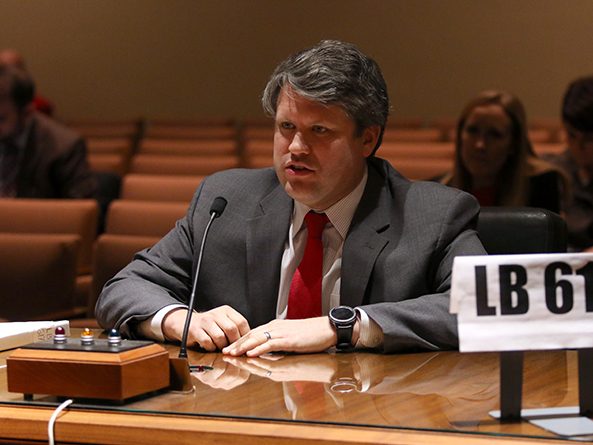Automatic cuts to top state income tax rates proposed
Cuts to Nebraska’s top individual and corporate income tax rates would be tied to projected economic growth under a bill heard Feb. 20 by the Revenue Committee.
LB615, introduced by Lincoln Sen. Mike Hilgers, would require the state tax commissioner to cut the top individual income and corporate tax rates—currently 6.84 percent and 7.81 percent, respectively—if projected state revenue growth is at least 3.5 percent and the state’s cash reserve fund holds at least $500 million. The cuts would occur in four annual steps until the rates reach 5.99 percent.
Each time the conditions for a rate cut are met, the state treasurer would transfer $75 million from the cash reserve to the property tax credit cash fund.
Assuming the bill’s requirements for a rate cut are met each year, the state Department of Revenue estimates that LB615 would reduce state income tax revenue by $15.7 million in fiscal year 2019-20, an additional $71.6 million in FY2020-21 and a further $158.3 million in FY2021-22.
Hilgers said the bill would provide additional property tax credits to agricultural producers and homeowners while also making the state’s top tax rates more attractive to individuals and businesses. He said elements of LB615 should be considered along with other proposals to reform the state’s tax code this session.
Joseph Young testified in support of the bill on behalf of the Nebraska Chamber of Commerce and Industry, the National Federation of Independent Businesses in Nebraska, the Nebraska Bankers Association and the Lincoln Chamber of Commerce. He said Nebraska’s high corporate and individual income tax rates make it uncompetitive with other states when trying to retain and attract people and businesses.
“We are in a fierce battle, obviously, for people and jobs in the state of Nebraska,” Young said. “The more we can do to make Nebraska competitive, the better off we will be in years to come, even if it’s at a slower rate than all of us would like.”
Nicole Fox, director of government relations at the Platte Institute, also testified in support, saying the bill is a fiscally responsible solution to the state’s “detrimentally high” tax rates. She said the rate cut triggers in LB615 do not guarantee tax cuts but only enable rate reductions when projections show that economic growth would offset a reduction in tax revenue.
“We would, however, caution the committee [against] using triggers based on expected growth and would rather see triggers based on actual receipts to ensure a safeguard against an overly optimistic forecast,” Fox said.
Testifying in opposition to the bill was Renee Fry, executive director of OpenSky Policy Institute. Fry said LB615 would deplete the state’s cash reserve and cut state tax revenue at a time when economists are predicting a recession. Similar automatic tax cuts led to a budget crisis in Oklahoma after falling oil prices caused an unexpected reduction in tax revenue, she said.
Most of the bill’s benefits would accrue to the wealthiest Nebraskans, Fry added. Once fully implemented, she said, the bill would give an average tax cut of $7,800 per year to the top 1 percent of income earners, $94 per year to those with middle incomes and $11 per year for the lowest earners.
John Hansen, president of the Nebraska Farmers Union, also testified in opposition. By cutting state income tax revenue, he said, LB615 would increase Nebraska’s overreliance on property taxes to fund K-12 education.
“This [bill], in our view, makes an already unfair and regressive state tax system worse,” Hansen said.
The committee took no immediate action on the bill.


